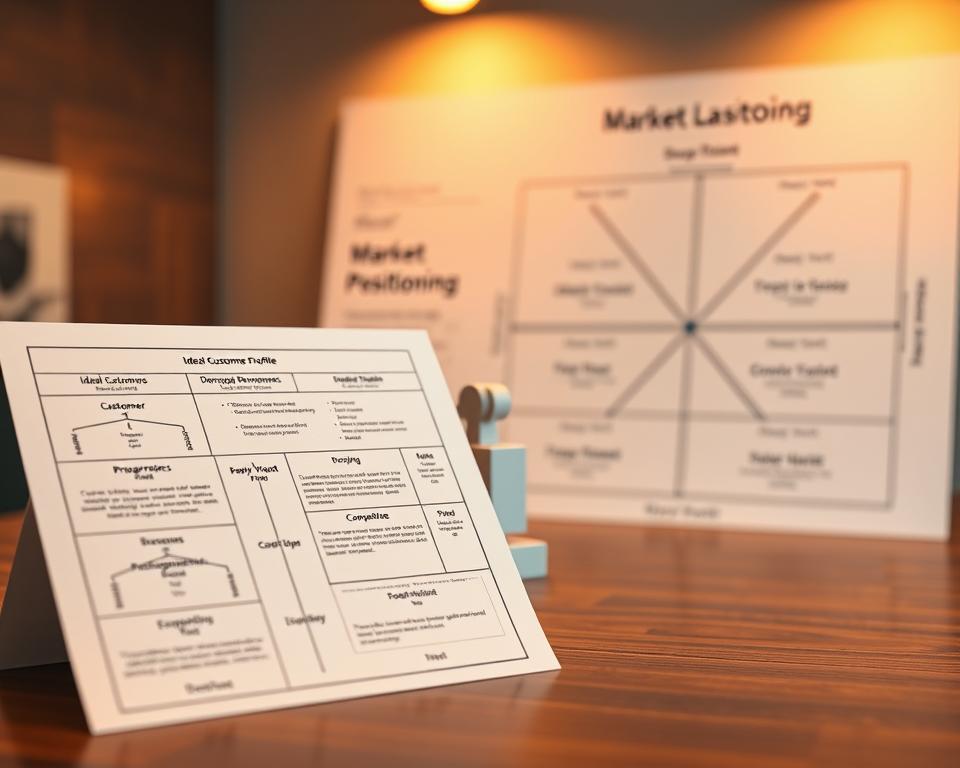Anúncios
What if your long-term roadmap could cut wasted effort, align hiring, and shape product choices so you actually reach your vision?
You will get clear, practical guidance to craft a plan that ties goals to measurable KPIs and real reviews. This introduction sets expectations for a guide grounded in facts and current examples from Apple, Walmart, Starbucks, Tesla, and Netflix.
Strategy is your long-term direction; tactics are the daily steps that support it. You will learn how to use SWOT, resource allocation, and BI dashboards so leaders can see progress and act.
Expect: concrete prompts, ethical considerations, and common pitfalls like quick templates or chasing every market trend. This guide helps you translate vision into measurable plans that drive growth while keeping customers and your company in mind.
Introduction: Why business strategy still sets winners apart in a fast-changing market
A clear business strategy keeps your team steady when markets shift. It helps you align vision, resources, and teams so your company makes deliberate choices instead of reactive moves. That alignment reduces wasted effort and creates a durable advantage for leaders navigating volatility.
Anúncios
In 2025, clarity, focus, and adaptability matter most. You need tight targets, real customer and market data, and a steady cadence that lets you adjust without losing direction. Predictive KPIs and BI dashboards make those adjustments visible and actionable.
This guide shows how to define vision and objectives, ground decisions in research and financial modeling, and pick a competitive path. You will see examples—Apple, Walmart, Whole Foods—that illustrate differentiation, cost leadership, and focus in practice.
Finally, the playbook covers execution rhythms, KPIs, and cross-functional alignment so every customer-facing function pulls the same way. U.S. leaders benefit from disciplined planning cycles that connect processes, marketing, and development to measurable goals and lasting value.
Anúncios
Foundations of an effective business strategy
When you know the destination, every action can be judged for impact.
حکمت عملی is the long-term plan; tactics are the short actions that test your choices. Keep this simple: the plan says where you will compete and why. Tactics show how you move day to day.
Core components
Build around five core elements so your organization stays focused:
- Vision: a clear image of future markets and customers.
- Objectives: measurable goals teams can own and track.
- SWOT: honest analysis of strengths, weaknesses, opportunities, and threats.
- Resources: allocate budgets and headcount to priorities, not habit.
- Evaluation: predictive KPIs and BI dashboards that reveal trends.
Why alignment matters
When leadership links goals to resources, silos fade. Teams make better day-to-day decisions because priorities are clear.
Watch for the quick-template trap
Template-only plans often become busy to-do lists without market analysis or BI. That creates short-lived operational plans, not a defensible company roadmap.
Turn vision into measurable goals that guide the whole organization
Turn a broad vision into clear, measurable targets that everyone can act on. A short, market-focused vision should name the customers, the markets, and the scale you expect.
Define a clear vision that describes future markets, customers, and outcomes
Write one sentence that states which markets you will serve, which customers matter most, and the outcome you seek. Keep it specific: include volume or revenue range when possible.
Translate vision into SMART objectives teams can own and track
Convert the vision into 3–5 SMART objectives. Each must be specific, measurable, achievable, relevant, and time-bound. Assign an owner and a monthly KPI.
Cascading alignment: connecting company goals to departmental roadmaps
Link company-level goals to department roadmaps so sales, marketing, product, and operations push the same priorities.
Use dashboards to make organizational goals visible and run monthly reviews. Require that budgets and headcount requests map directly to an objective to preserve focus.
Use market analysis and SWOT to ground your choices in facts
Build forecasts from customer jobs-to-be-done and clear financial models.
Start by defining the market: size, key segments, and the jobs your customers hire your product to do.
Customer and market insights: pairing research with financial modeling
Pair qualitative research with a simple financial model. Test scenarios for price, channel costs, and acquisition to see which moves create lasting value.
Competitive intelligence: define your arena and rivals’ strengths
Map rivals using public records and third‑party datasets. Note where competitors excel so your company can claim a clear, differentiated position.
SWOT with humility: identifying strengths to leverage and gaps to address
Run a rigorous swot analysis that admits uncomfortable truths. Highlight strengths you can scale and the opportunities you must close.
- Define market segments and link them to revenue scenarios.
- Use public data to challenge assumptions and refine goals.
- Test product elasticity and channel economics before large bets.
Example: a Vistage case found deepening current markets beat a geography grab—let model outcomes drive your decisions, not instincts.
Choose and prove your competitive advantage
Pick the path that matches your strengths, cost base, and what customers truly value. Each route—uniqueness, low cost, niche focus, premium value, vertical control, or deeper market share—requires different investments and trade-offs.
Differentiation and brand experience
When to pick it: you have a clear design or service edge and customers who will pay more.
Example: Apple pairs integrated products and services to create lock-in and justify premium pricing.
Cost leadership
When to pick it: you can scale operations and squeeze unit costs without harming quality.
Example: Walmart uses logistics, supplier terms, and volume to win on price and sales.
Focus on a niche
When to pick it: narrow segments reward depth over breadth and build loyalty.
Example: Whole Foods trades wider assortment for a trusted specialty offer.
Value-based pricing
When to pick it: the experience lifts perceived value beyond commodity costs.
Example: Starbucks charges for atmosphere, service, and brand as much as for the product.
Vertical integration
When to pick it: controlling supply or interfaces speeds innovation or protects quality.
Example: Tesla integrates key components to tighten product development and customer touchpoints.
Market penetration and expansion
When to pick it: you can adapt offerings locally or scale distribution efficiently.
Examples: McDonald’s deepens share with local menus; Netflix expands by local content and localization.
Test before you commit: pressure-test your hypothesis with customer research and unit economics. Use pilots and clear KPIs so the chosen path shows measurable lift before you reallocate major resources.
From targets to market: ICP, positioning, pricing, and demand
Precision in who you serve shrinks wasted effort and sharpens every message. Start by defining a narrow ideal customer profile (ICP) that ties firmographics, buying triggers, and pain points to measurable signals.

Define your ideal customer profile and tight targets
List the attributes of your highest-value customers: size, industry, role, budget, and trigger events. Score prospects so sales and marketing can prioritize the same accounts.
Use a small pilot segment to test messaging and cadence before you scale. For steps and templates, see our ICP marketing guide.
Positioning and messaging across teams
State who you serve, why you win, and how you deliver. Create one-line positioning and three proof points that sales, product, and marketing use verbatim.
Train reps with two play scripts that map to buyer stages and objections so messages remain consistent in every channel.
Pricing, demand, and enablement
Align price to perceived value, segment expectations, and your cost structure. Test tiers and promos on a small sample to preserve margins.
Then link demand generation to sales enablement so content, campaigns, and playbooks move the same prospects through conversion and retention.
- Map processes that ensure consistent customer experiences across touchpoints.
- Define goals for pipeline quality, conversion steps, and retention with owners and monthly reviews.
Execution discipline: operating cadence, KPIs, and resource allocation
Set a repeating cadence that turns plans into measurable actions and fast learning. You will run monthly operating reviews and build a quarterly pivot window so small signals inform larger course changes without derailing the plan.
Pick predictive KPIs tied to outcomes you care about: revenue, gross profit or EBITDA, market share, and brand indicators. Use these metrics as the core signals that predict future performance.
Build a rhythm of reviews and pivots
Hold brief monthly check-ins focused on results, risks, and corrective actions. Reserve one quarterly session to test assumptions and reallocate resources if evidence supports a change.
Cascade goals and own outcomes
Translate company objectives into team-level targets so each group owns measurable outcomes. Clear owners and deadlines make management routines faster and reduce wasted time.
Align resources and visibility
Allocate people, tech, and capex to the highest-return bets. Deploy BI dashboards so leadership and the organization get near real-time visibility and can course-correct quickly.
- Connect sales activity and market indicators to forecast models.
- Document learnings and revisit competitive advantage as evidence accumulates.
- Keep the plan living so you close gaps and capture opportunities with clear trade-offs.
Stay adaptable: planning horizons, external forces, and emerging trends
Design a yearly framework with built-in checkpoints so you can act on new information quickly.
Annual cycles with flexible checkpoints
Set an annual planning cycle as your baseline and add short monthly or quarterly checkpoints. These reviews let leadership reassign resources without rewriting the whole plan.
Scan competition, regulation, and customer shifts
Make routine scans of rivals, legal changes, and evolving customer needs. That lets your organization respond thoughtfully instead of reacting under pressure.
Sustainability as an operational advantage
Embed sustainability to cut costs, reduce risk, and build trust with customers. Small efficiency moves can protect margins and guard reputation when markets tighten.
AI and data for clearer forecasting
Use AI and simple data models to improve forecasts and refine segmentation. Better visibility across teams speeds execution and highlights when to pivot.
- Design an annual cycle with flexible checkpoints to adjust without full redesign.
- Scan competition, regulation, and customer shifts for timely responses.
- Embed sustainability for efficiency, risk control, and trust.
- Use AI and data to sharpen forecasting, segmentation, and performance visibility.
- Set leadership routines that revisit assumptions and reallocate resources as the market changes.
Practice: stress-test growth paths with scenarios and document triggers that prompt action. Keep focus by limiting active initiatives and sequencing development so your company can support outcomes.
Conclusion
Good planning turns vision into steps you can measure and improve. Use a clear plan to translate your mission into objectives, align resources, and pick the business approach that fits your strengths and customers.
Make the plan living: run monthly reviews, track KPIs on dashboards, and test choices with SWOT and pilots. Refer to real examples when you pressure‑test options, but avoid copying playbooks that don’t match your products or services.
There are no guarantees: growth and success depend on trade‑offs, timing, and disciplined execution. Before major moves, consult qualified financial, legal, and sustainability professionals to protect value and long‑term advantage.


